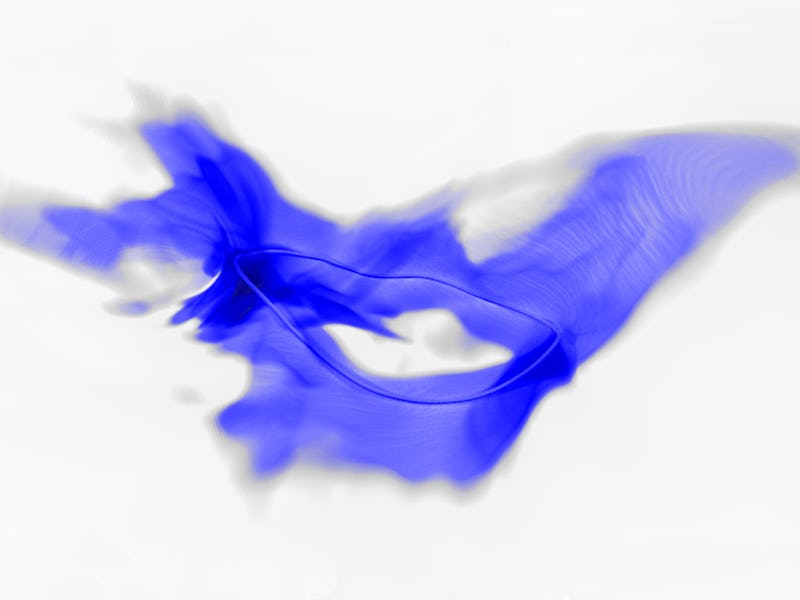Physicists discover a massive problem with the search for dark matter
Whoops.

Dark matter is elusive, complex, and perhaps far more massive than we thought.
A recent simulation of the early universe suggests that one of the most promising targets in the hunt for dark matter — a fundamental, subatomic particle called an axion — may be twice as massive as they presumed.
The results upend the search for dark matter — already one of the most mysterious forces in the universe. The findings are detailed in a new study published in Nature Communications.
The discovery — It all began with a precise pursuit: At Berkeley Lab’s National Energy Research Scientific Computing Center, a team of scientists set out to recreate the conditions of the very early universe in a lab.
They specifically simulated an era when axions are thought to have appeared — a fraction of a billionth of a second after the universe came into existence 13.8 billion years ago.
In the supercomputer simulation, a small part of the rapidly expanding, infant universe is represented inside a three-dimensional grid. Following initial inflation, right after the cosmos was born, little tornadoes, or vortices, formed in the shape of strings and threw off axions into the maelstrom.
The early universe simulation shows the axion energy density varying from high, represented by yellow through blue and red, to a low, represented by black.
The axions try to hold onto the vortices as they spiral around, forming loops while the universe continues to expand.
“The axions hugging the sides of these strings are trying to hold on for the ride,” Benjamin Safdi, assistant professor of physics at the University of California, Berkeley, and co-author of the paper, says in a statement.
“But when something too violent happens, they just get thrown off and whip away from these strings. And those axions which get thrown off of the strings end up becoming the dark matter much later on.”
As the axions were thrown off, the researchers tracked them to try and measure how much dark matter they produced as a result.
But their data may have created a different storm for theoretical physics to weather: As they followed the simulation, the researchers calculated the axion’s mass to be more than 100 percent larger than they had previously believed. An axion, according to their work, is between 40 and 180 microelectron volts, or about one 10-billionth the mass of the electron.
WHY IT MATTERS — The hunt for dark matter is essentially a hunt for axions — so if physicists have been trying to spot particles with a far lower mass than they truly hold then it means that past and ongoing efforts to find dark matter may be doomed by design.
Right now, the most promising experiment built to snag axions is a microwave resonance chamber, which uses a strong magnetic field to convert axions into a faint electromagnetic wave that scientists are able to detect much more easily.
But if axions weigh twice as much as we thought, then the chamber has to be made much smaller than a few centimeters on one side in order to detect the higher-mass axion. On the plus side, at least now physicists may have a more exact idea of what they need to be looking for.
HERE’S THE BACKGROUND — It is a fitting result to add to the giant enigma that is dark matter, which is a type of matter that doesn’t reflect, emit, or absorb light, and may only interact with other matter through gravity.
Although we are unable to detect dark matter directly with current technology, dark matter makes up around 27 percent of the universe's total mass, outweighing visible matter around six to one. Around 68 percent of the remaining mass is dark energy, with just five percent left to ordinary “baryonic” matter, aka the objects we directly observe, like planets and stars.
Researchers are quite confident dark matter exists — but they haven’t been able to prove it with direct, observational evidence. They know it’s there because it exerts a gravitational effect on the motion of stars and galaxies. Dark matter moves galaxies in ways that all the observable matter can’t manage.
WHAT’S NEXT — Axions have recently emerged as the top candidate for dark matter particles. It is a hypothetical particle with low mass and it does not interact with other particles.
“Still to this day, the axion is the best idea we have about how to explain these weird observations about the neutron,” Safdi says.
“It could be created in abundance in the Big Bang and be floating out there explaining observations that have been made in astrophysics.”
The team behind the recent experiment hopes to design an even more precise simulation to reduce the margin of error behind the mass of the axion.
“We want to make even bigger simulations at even higher resolution, which will allow us to shrink these error bars, hopefully down to the 10 percent level,” Safdi says.
“We could never simulate our entire universe because it’s too big. But we don’t need to stimulate our entire universe. We just need to simulate a big enough patch of the universe for a long enough period of time, such that we capture all of the dynamics that we know are contained within that box.”